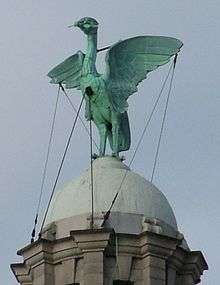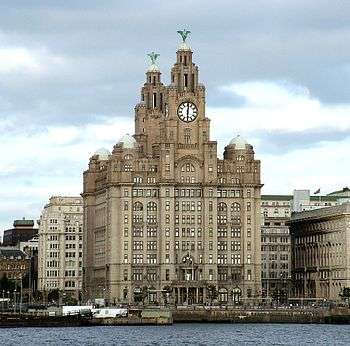Liver bird

The liver bird /ˈlaɪvərbɜːrd/ is the symbol of the English city of Liverpool. The use of a bird to represent the city dates to the medieval era, but the idea that the "liver bird" is a mythical creature specific to Liverpool evolved in the 20th century. The bird is normally represented in similar form to a cormorant, and appears as such on Liverpool's coat of arms.
History

The name of Liverpool may derive from words meaning a pool or creek with muddy water,[1] though other origins of the name have been suggested. The earliest known use of a bird to represent the town of Liverpool was on its corporate seal, dating from the 1350s. The seal is now held by the British Museum.[2] In 1668 the Earl of Derby gave the town council a mace "engraved with ...a leaver", the first known reference to a liver bird by this name. In 1797 the College of Arms granted official arms to Liverpool, which depicts the bird in pride of place. The College of Arms now refers to the bird as a cormorant, adding that the sprig in the mouth is of laver, a type of seaweed, thus implying that the bird's appellation comes from the sprig.
Representations of the bird can be found throughout Liverpool. Two birds top the clock towers on the Royal Liver Building, at Liverpool's Pier Head, overlooking the Mersey. The building, headquarters to the Royal Liver Assurance, is probably the best-known in the city and was opened in 1911. Each tower is topped by a metal sculpture of a cormorant-like liver bird, designed by Carl Bernard Bartels and constructed by the Bromsgrove Guild.
There are two less well-known liver birds in the city. A third metal bird is on the nearby Mersey Chambers office building, adjacent to the Church of Our Lady and St Nicholas, the parish church of the city of Liverpool. The fourth, a bird carved in stone, topped the original St John's Market building until its demolition in 1964. The stone liver bird is now displayed at the Museum of Liverpool.
Possible species

The bird's species has long been the subject of confusion and controversy.
The bird shown on the medieval seal is generic, but the wording of the seal contains references to King John, who granted the town's charter in 1207. John, in honour of his patron saint, frequently used the device of an eagle – long associated with St John. Further indication that the seal was an homage to King John is found in the sprig of broom initially shown in the bird's beak, broom being a symbol of the royal family of Plantagenet.
By the 17th century, the origins of the bird had begun to be forgotten, with references to the bird as a cormorant, still a common bird in the coastal waters near Liverpool. The 17th century mace refers to a "leaver", while a manual on heraldry from later in the century confuses matters further by assuming this term is related to the old Low Dutch word lefler, meaning spoonbill.[3] – a bird rarely found in northern England.
The bird thus appears to have originally been intended to be an eagle, but is now officially a cormorant. Many modern interpretations of the symbol are of a cormorant, although several – notably that on the emblem of Liverpool Football Club – distinctly show the short head and curved beak more readily associated with a bird of prey.
Everton Football Club, however, was the first football club to use the Liver Bird symbol, on its medals and souvenirs up until the 1930s when it was replaced by Prince Rupert's Tower, another iconic Liverpudlian symbol, in 1938. The club commissioned the incorporation of the Liver bird on the league championship winners' medal in 1890, Everton's first ever championship title, won at Anfield, their home ground at that time. Some fans still believe the symbol should be used on the club's strip, arguing that it should be a representation of both clubs in the city.[4]
Modern myths and popular culture
The modern popularity of the symbol largely dates to 1911, when the Liver Building was built. This prominent display of two liver birds rekindled the idea that the liver was a mythical bird that once haunted the local shoreline. According to popular legend, they are a male and female pair, the female looking out to sea, watching for the seamen to return safely home, while the male looks towards the city, making sure the pubs are open. An alternative version says that the male bird is looking in to watch over and protect the families of the seamen. Local legend also holds that the birds face away from each other as, if were they to mate and fly away, the city would cease to exist. In fact, they were indeed designed to watch the city (our people) and the sea (our prosperity). Another legend says that if an honest man and a virgin woman were to fall in love in front of the liver birds that the couple of liver birds that are in statue form would come to life and fly away, and Liverpool would cease to exist.
Another popular story told about them is that they are chained down, as if they were to fly away the River Mersey would burst its banks and flood the city of Liverpool. This is somewhat similar to the mating story.
During the 1970s, The Liver Birds was the name of a popular British sitcom dealing with two young women in Liverpool, a play on the British slang term "bird" meaning a young woman.
The crest of Sir Paul McCartney is a calling liver bird holding a guitar, in reference to his profession and native city.[5]
Trademark
In November 2008, Liverpool Football Club attempted to trademark the version of the liver bird shown on the club badge to stop false club merchandise. The deputy council leader, Flo Clucas, responded that "The Liver bird belongs to all the people of Liverpool and not one company or organisation."[6]
The Liver bird also forms part of the logo of the University of Liverpool, its Medical Students Society, Liverpool John Moores University and Edge Hill University. The Liverpool Echo also has a slightly altered version of the liver bird featured on Liverpool FC's emblem on its front page, the differences being it is drawn slightly rounder and carrying a rolled up newspaper instead of a branch.
Liverpool FC finally trademarked the liver bird in September 2010, after coming to an agreement with the city council. Liverpool FC trademarked it with the European trademark office (TMDREU) and the council filed a trademark with the UK's IPO. This was done to protect its use by companies in Liverpool, but also for the football club to protect itself against counterfeit products.[7]
References
- ↑ "Liverpool King John Charter 1207 Text only version". The History of Liverpool. Retrieved 25 November 2015.
- ↑ Liverpool museums – Maritime Archives Information Sheet No. 21 : Liver Bird
- ↑ Heraldry Society Gazette, March 2008
- ↑ "Everton FC". Liverpoolecho.co.uk. Retrieved 2016-10-09.
- ↑ Findlater, Alexander (March 2003). "Sir Paul McCartney". The Heraldry Society.
- ↑ "BBC NEWS - UK - England - Merseyside - Flap over Liverpool's bird symbol".
- ↑ David Bartlett (4 September 2010). "Liverpool FC trademarks the Liver Bird". Liverpool Echo. Retrieved 14 May 2015.
External links
![]() Media related to Liver birds at Wikimedia Commons
Media related to Liver birds at Wikimedia Commons
- The oldest Stained Glass Liver Bird
- Mersey Maritime Museum
- The Liver Building
- History and pictures, plus a campaign to add a third bird to the Liver Building
